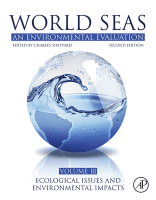World Seas are in peril: Hypoxia in Baltic Sea as an examplePerjantai 5.6.2020 klo 18.40 - Mikko Nikinmaa Human activities have affected world seas in various ways. A three-volume book on environmental evaluation of world seas has just been published by Elsevier (World Seas: an Environmental Evaluation). In two volumes it evaluates the environmental statuses of different sea areas and in one volume the major environmental problems affecting marine environments. The book’s aim is both to evaluate the present statu There have always been virtually anoxic bottom areas in the Baltic Sea, but they have increased markedly because of human actions. For example, the area with low oxygen (less than 2 mg/l) has increased tenfold from preindustrial times. The main reason for hypoxic/anoxic sea bottoms is that for about 50 years paper and pulp mill industry’s wastewater was entered the sea uncleaned. The biological oxygen consumption of the waste is approximately the same as that of 100 million people’s waste. Since the waste of tens of millions of people also entered the sea without treatment, the sea bottom now contains so much organic material and nutrients that even without any further wastewater or fertilizer discharges, the Baltic Sea would remain eutrophicated and have large hypoxic areas for tens of years. Hypoxia is caused by the consumption of oxygen by organisms or organic material, if it exceeds the diffusion of oxygen from atmosphere and its transport from oxygen-rich waters. In the Baltic Sea the water is stratified, and the high-temperature, low- salinity water which is oxygen-rich does not circulate with the dense oxygen-poor bottom water. The bottoms get oxygenated water only, when pulses of oceanic oxygen-rich waters displace the bottom areas. When this happens, the low-oxygen water, which has high nutrient content, will be transported to lower depths and to Gulf of Finland and also in small amount to Gulf of Bothnia. Because large amounts of phosphorus and nitrogen are liberated, primary production increases, and generation of hypoxia occurs in new areas. The increase of temperature causes increased oxygen consumption of all poikilothermic animals. Thus, climate change increases the likelihood of hypoxic periods. Also, if the predictions of increased rainfall during winter remain accurate, the phopshorus and nitrogen discharges during natural river flow to the Baltic increase markedly. Although eutrophication is usually linked only to increased plant, algal and cyanobacterial growth, the end result is always hypoxia. In shallow areas eutrophication leads to intermittent hypoxia. During the day, when there is enough light for photosynthesis, green plants and algae liberate oxygen, and the water often becomes hyperoxic. At night plants, algae, bacteria and animals all only consume oygen, rendering water hypoxic. The oxygen consumption by animals always consumes oxygen, but probably the most important reason for hypoxia is the oxygen consumption of microbes, which eat up all the dead plants, algae, cyanobacteria and animals entering the bottom. There is a group of bacteria which forms bacterial mats to bottoms with very low oxygen. If one considers communities, hypoxia generally decreases diversity and changes species composition. As an example, at group level, fish disappear first, and are replaced by jellyfish. Among macrofauna, polychaetes survive at lowest oxygen level. With lowering of oxygen level, microfauna and microbes replace macrofauna. Hypoxia reduces the growth of animals and as a consequence fish catches are reduced. Additionally, hypoxia-tolerant species are usually of reduced commercial value. Thus, the Baltic Sea fisheries are markedly suffering from the spreading of hypoxic areas.
|
|
Avainsanat: climate change, environmental pollution, eutrophication |

 s and to evaluate the future of the seas. It would be impossible to give a comprehensive review of the book’s contents, so I take one environmental problem, hypoxia, in one sea area, the Baltic Sea as an example.
s and to evaluate the future of the seas. It would be impossible to give a comprehensive review of the book’s contents, so I take one environmental problem, hypoxia, in one sea area, the Baltic Sea as an example.